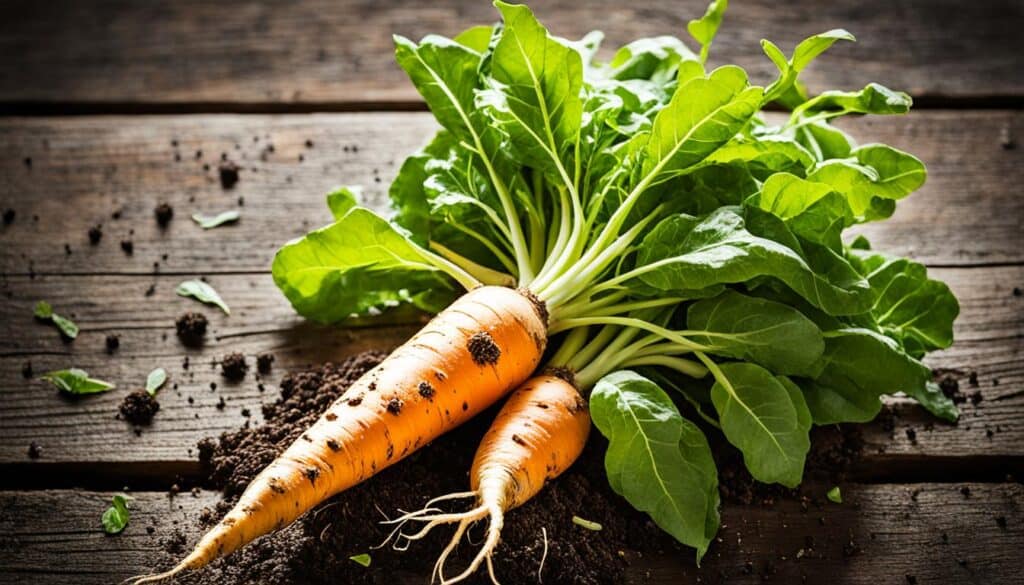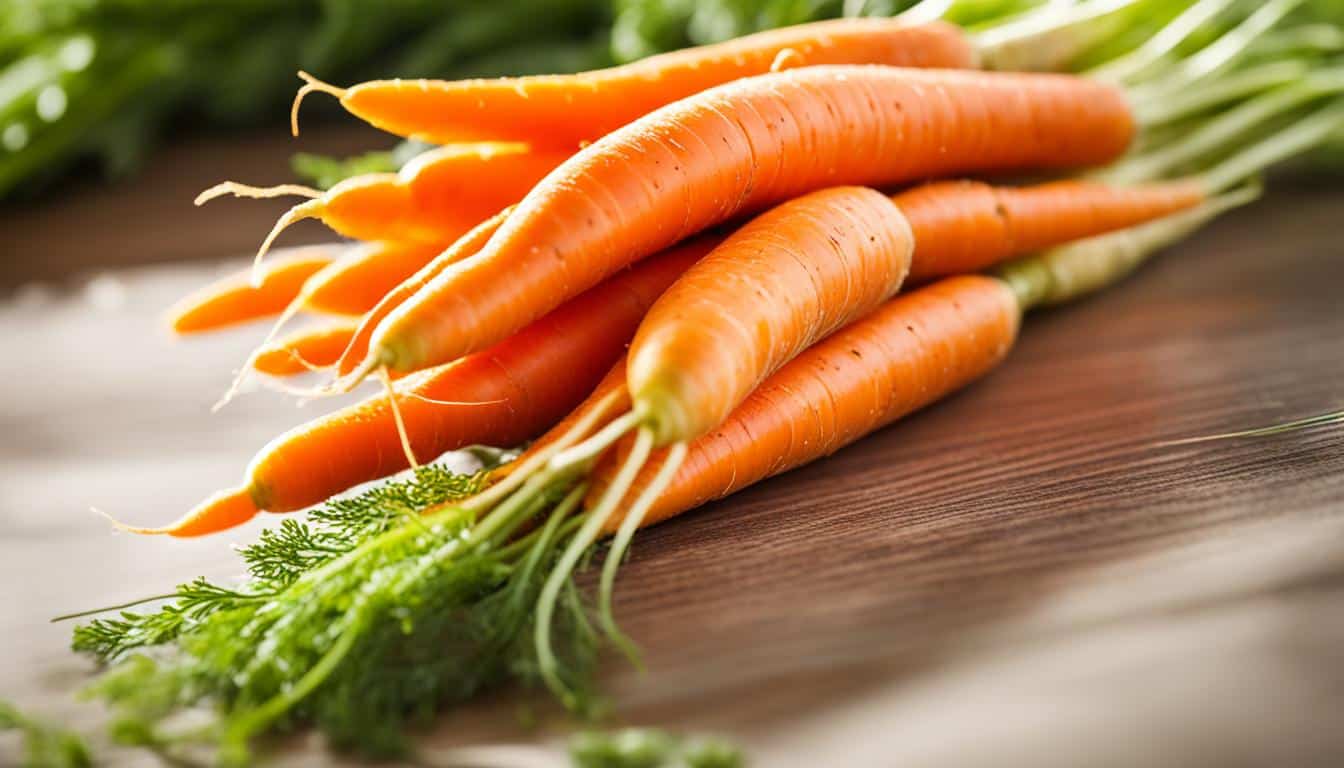Did you know that the word for carrot in Spanish is “zanahoria”? Yes, that’s right! The vibrant term for this vibrant vegetable in the Spanish language is as colorful as the carrot itself. With its rich history and linguistic significance, understanding how to say carrot in Spanish opens up a whole new world of culinary exploration.
Whether you’re a language enthusiast, a curious foodie, or simply want to expand your culinary vocabulary, learning about carrot in Spanish, or “zanahoria en español,” is the perfect starting point. So, let’s dive into the fascinating world of carrots and uncover the hidden flavors behind the translation.
Key Takeaways:
- The Spanish word for carrot is “zanahoria.”
- Understanding culinary translations in different languages enhances our culinary vocabulary.
- Carrots have a diverse range of colors, including orange, purple, black, red, white, and yellow.
- Carrots are rich in essential vitamins and compounds with numerous health benefits.
- Exploring the cultural significance of carrots in different cuisines can broaden our culinary horizons.
The Myth of Orange Carrots and the Dutch Royal Family
Did you know that there’s an interesting folklore surrounding orange carrots and the Dutch royal family? Legend has it that Dutch farmers developed orange varieties of carrots as a tribute to William, Prince of Orange, who played a pivotal role in the Dutch Revolt. This story has been passed down through generations, but is there any truth to it? Let’s find out.
In reality, there is no concrete evidence to support the claim that orange carrots were bred as a symbol of respect for the Dutch royal family. The development of orange carrots actually predates the Dutch Revolt by centuries. Carrots, in their original form, have been cultivated in various colors for centuries, including purple, yellow, and white.
“The myth that orange carrots were created by Dutch farmers as a tribute to the Dutch royal family is not backed by historical evidence.” – Professor Carrot Expert
The popularity of orange carrots can be attributed to selective breeding and the preference for sweeter and less bitter carrots. Over time, orange carrots gained popularity for their vibrant color, appealing flavor, and high beta-carotene content.
So, while the story of orange carrots being tied to the Dutch royal family is captivating, it remains a figment of folklore rather than historical fact. The true origins of orange carrots lie in the natural variation of carrot colors and the preferences of cultivators over centuries.
The History and Cultivation of Carrots
Carrots have a long and fascinating history, with origins traced back to Persia. They were initially cultivated for their leaves and seeds, rather than their roots. Through generations of selective breeding, the familiar carrot root that we know today was developed.
Carrots come in a variety of colors, each with its own unique characteristics. In addition to the traditional orange carrots, you can find purple, black, red, white, and yellow carrots. These diverse colors add vibrancy and interest to culinary preparations.
Now, let’s take a closer look at the cultivation process and the historical significance of carrots.
The Origins of Carrots
The cultivation of carrots began in ancient Persia, where they were initially grown for their aromatic leaves and their seeds. These early carrots had a range of colors, including purple, yellow, and white. Over time, they spread to other parts of the world, including Europe, Asia, and North Africa.
“The cultivation of carrots began in ancient Persia, where they were initially grown for their aromatic leaves and their seeds.”
Carrots were highly valued for their medicinal properties and were used to treat ailments such as digestive disorders and respiratory conditions. They were also recognized for their ability to improve vision, leading to the modern belief that carrots are good for the eyes.
Selective Breeding and the Development of Carrot Roots
Through generations of selective breeding, farmers focused on cultivating carrots with larger and sweeter roots. Over time, this led to the development of the familiar elongated orange carrot roots that are commonly seen today.
Carrots’ characteristic orange color is due to the presence of beta-carotene, which is converted into vitamin A by the body. Beta-carotene is also responsible for the vibrant colors found in purple, red, and yellow carrots.
The cultivation and popularity of carrots spread across different civilizations, including the Romans, Egyptians, and Persians.
Carrots in Different Cultures and Traditions
Carrots have played a significant role in culinary traditions around the world. From European dishes such as carrot cake and stewed carrots to Asian cuisines like stir-fried carrots in Chinese cuisine and carrot kimchi in Korean cuisine, this versatile vegetable adds depth and flavor to a wide range of recipes.
In Spanish, the word for carrot is “zanahoria,” and it holds a special place in Spanish cuisine. It is a staple ingredient in dishes like gazpacho, ensalada de zanahorias (carrot salad), and various stews and soups.
Carrot Cultivation Today
Carrots are now grown globally, with major producers including China, Russia, and the United States. They are a popular vegetable due to their sweet flavor, versatility, and nutritional value.
“Carrots are a popular vegetable due to their sweet flavor, versatility, and nutritional value.”
Carrots are not only a delicious addition to our meals but are also packed with beneficial nutrients. They are an excellent source of vitamin A, vitamin K, and vitamin B6. Additionally, carrots contain antioxidants and fiber, which contribute to overall health and well-being.
Carrots are a widely consumed vegetable that holds cultural, culinary, and nutritional significance. Exploring their history and cultivation adds depth to our understanding and appreciation for this vibrant and versatile root vegetable.
| Carrot Varieties | Colors |
|---|---|
| Orange carrots | Orange |
| Purple carrots | Purple |
| Black carrots | Black |
| Red carrots | Red |
| White carrots | White |
| Yellow carrots | Yellow |
The varied colors of carrots offer a visual feast and unique flavors.
Carrots are truly a versatile and vibrant vegetable, adding color, flavor, and nutrition to our plates. Whether you enjoy them raw, steamed, or roasted, the story of carrots is as rich as the nutrients they provide.
The Nutritional Value of Carrots
Carrots are not only delicious but also incredibly nutritious. They are packed with essential vitamins, minerals, and compounds that promote overall health and well-being. Let’s explore the incredible nutritional value of carrots.
Vitamin Powerhouse
Carrots are a rich source of various vitamins, including:
- Vitamin A: Carrots are famous for their high vitamin A content. This nutrient is essential for maintaining good vision, supporting a healthy immune system, and promoting cell growth and development.
- Vitamin K: Carrots also provide a significant amount of vitamin K, which is crucial for blood clotting and maintaining strong bones.
- Vitamin B6: B6 plays a vital role in brain development, hormone regulation, and the production of red blood cells.
Powerful Antioxidants
In addition to vitamins, carrots contain powerful antioxidants that help protect the body from free radicals and oxidative stress. Some of the notable antioxidants found in carrots include:
- Alpha- and Beta-Carotene: Carrots are loaded with these carotenoids, which give them their vibrant orange color. These compounds serve as precursors to vitamin A, offering antioxidant benefits and promoting healthy skin and a strong immune system.
- Lycopene: This antioxidant gives certain fruits and vegetables, including carrots, their red or pink color. Lycopene is associated with reducing the risk of chronic diseases, such as heart disease and certain types of cancer.
- Anthocyanins: While most carrots are orange, some varieties are purple or red due to anthocyanins. These antioxidants have anti-inflammatory properties, supporting overall health and wellness.
- Lutein: Lutein is another important antioxidant found in carrots that is beneficial for eye health. It is particularly effective in protecting against age-related macular degeneration and reducing the risk of cataracts.
With their impressive nutrient profile, including vitamins, minerals, and antioxidants, adding carrots to your diet can provide numerous health benefits. So, don’t forget to include this vibrant vegetable in your meals regularly.
Carrots are not only nutritious but also incredibly versatile. In Spanish, the word for carrot is “zanahoria,” and in Castilian Spanish, it is “zanahoria en castellano.” Incorporating zanahoria into your dishes can add both color and flavor to your culinary creations. So, why not enjoy the goodness of zanahoria en español and reap its health benefits?
Carrots in Different Cultures and Cuisines

Carrots are incredibly versatile and widely used in various cultures and cuisines around the world. In fact, their vibrant colors and earthy flavors make them a popular ingredient in many traditional dishes. In the Spanish language, the word for carrot is “zanahoria.” Let’s take a closer look at how carrots are incorporated into different culinary traditions and how the Spanish-speaking world embraces this humble vegetable.
Culinary Delights from Spain
In Spain, carrots are a common ingredient in various dishes, adding both flavor and vibrant color. One classic Spanish recipe that features carrots is Paella, a renowned rice dish enriched with vegetables, saffron, and a medley of meats and shellfish. Carrots add a touch of sweetness and texture to this delectable dish.
| Spanish Carrot Dishes | Description |
|---|---|
| Gazpacho | A chilled tomato-based soup that often includes finely diced carrots for added texture and color. |
| Tortilla Española | A traditional Spanish omelet made with eggs, potatoes, and sometimes carrots, creating a hearty and satisfying dish. |
| Escabeche de Zanahorias | Marinated carrots in a fragrant sauce made from vinegar, olive oil, and aromatic spices. |
Carrots across Latin America
Carrots are also widely used in Latin American cuisines, adding a pop of color and flavor to many traditional dishes. From the hearty Sancocho in the Dominican Republic to the vibrant Ajiaco in Colombia, carrots play a crucial role in various soups and stews across the region, providing both nutrients and a hint of sweetness.
Asian Influence
The influence of carrots goes beyond the borders of Europe and Latin America, extending into Asian cuisines as well. In many Asian countries, carrots are often used in stir-fries, salads, and side dishes. They bring a crisp texture and a mild sweetness to dishes, complementing the other flavors and ingredients.
“Carrots are not only a crucial component of Western cuisines but also play an important role in diverse culinary traditions around the globe, bringing their vibrant color and nutritional value to a multitude of dishes.”
Incorporating Carrots Into Your Culinary Exploration
Exploring the cultural significance of carrots in different cuisines can enhance our appreciation for this versatile vegetable. Whether you’re making a Spanish Paella, a Latin American Sancocho, or an Asian stir-fry, adding carrots will not only elevate the taste but also contribute to a visually appealing dish.
By incorporating carrots into your culinary explorations, you can unlock a world of delicious flavors and cultural connections. The Spanish word for carrot, “zanahoria,” reminds us of the linguistic diversity that enriches our gastronomic experiences. So, embrace the versatility of carrots and savor the global influence they bring to the table.
How to Say Carrot in Spanish

If you want to learn how to say carrot in Spanish, the word you need to use is “zanahoria.” It is a straightforward translation that can be easily incorporated into your vocabulary. Whether you are traveling to a Spanish-speaking country or simply want to communicate about carrots with Spanish-speaking individuals, knowing the translation for carrot in Spanish can be beneficial.
The Linguistic Significance of Carrot in Spanish
As we delve into the world of culinary vocabulary, exploring the linguistic significance of “carrot in Spanish” or “zanahoria en español” can provide fascinating insights into the etymology and history of this vibrant term. The Spanish language has its own distinctive terminology for various culinary items, reflecting the rich diversity of food culture and language. “Zanahoria” has become an integral part of the Spanish culinary vocabulary, essential for effective communication in Spanish-speaking environments.
Understanding the linguistic significance of “carrot in Spanish” allows us to appreciate how language mirrors culture and how a simple word can encapsulate centuries of culinary traditions and influences. The term “zanahoria en español” not only represents the carrot itself but also serves as a gateway to exploring the gastronomic heritage of Spanish-speaking regions and their unique culinary identities.
“Zanahoria en español” is more than just a name for a vegetable; it carries the weight of tradition and cultural heritage, connecting us to the vibrant culinary tapestry of the Spanish-speaking world.
By diving into the linguistic nuances and meanings associated with “zanahoria,” we gain a deeper understanding of how language shapes our perception of food. Through this exploration, we can uncover hidden layers of history, migration, and cultural exchange that have influenced the development of culinary terms across different languages.
The Evolution of “Zanahoria”
The word “zanahoria” has ancient roots, harking back to the Persian word “zanir,” which referred to a plant with an edible root. Over time, as the cultivation and consumption of carrots spread across continents, variations of the word emerged in different languages, each reflecting the unique linguistic characteristics of their respective cultures.
Today, “zanahoria” is universally recognized as the Spanish word for carrot. Whether you find yourself in Spain, Mexico, or any Spanish-speaking country, using this term will ensure clear and effective communication when discussing this beloved vegetable.
Delving into Food Culture and Language
Exploring the linguistic significance of “carrot in Spanish” encourages us to go beyond translation and delve into the stories, traditions, and flavors that shape a culture’s food identity. Just as “zanahoria” represents the carrot in Spanish, it also encapsulates the essence of Spanish cuisine and its diverse culinary traditions.
By embracing the linguistic diversity of culinary terms, we gain a deeper appreciation for the cultural significance of food and how language acts as an ever-evolving conduit for transmitting centuries of culinary knowledge and heritage.
Un viaje a través de las zanahorias
La zanahoria en español es mucho más que un simple nombre para una hortaliza. Representa una rica herencia cultural, que nos transporta a través de los sabores, aromas y tradiciones de la gastronomía hispana. La zanahoria es el enlace que une a las diversas culturas y comunidades de habla hispana a través de su lenguaje culinario.
Sumergirse en la importancia lingüística de “la zanahoria en español” o “carrot in Spanish” nos permite explorar la historia culinaria de las culturas hispanohablantes de una manera dinámica y significativa. Desde las recetas tradicionales de la cocina española hasta los platos típicos de América Latina, la zanahoria en español desempeña un papel central en las creaciones culinarias de estas comunidades.
Con su tonalidad anaranjada y su sabor dulce y terroso, la zanahoria se ha ganado un lugar de honor en cocinas de todo el mundo. Ya sea que estés disfrutando de una deliciosa paella en España, savoring a traditional Mexican carrot cake, cabbage and carrot coleslaw, or indulging in a delectable carrot and ginger soup in Argentina, the word “zanahoria” has the power to connect communities and cultures through a shared love for this vibrant vegetable.
The Beauty of Language and Food
Language has the power to transcend boundaries and open doors to new culinary adventures. By embracing the linguistic significance of “carrot in Spanish,” we embark on a journey that not only enhances our understanding of food culture but also allows us to forge deeper connections with others.
So, the next time you encounter a “zanahoria,” remember that you are not just experiencing the joy of a carrot but also immersing yourself in the rich tapestry of language, tradition, and flavor that the Spanish-speaking world has to offer.
Carrots and Color Varieties

Carrots come in different colors, each with its own unique properties and characteristics. In Spanish, the word for carrot is zanahoria. Exploring the various color varieties of carrots and their corresponding names in Spanish can provide a deeper appreciation for the diversity and versatility of this vegetable. Let’s take a closer look at some of the prominent color varieties of carrots:
Orange Carrots
Orange carrots are the most commonly known variety and are loaded with beta-carotene, which is converted by the body into vitamin A. They have a sweet and slightly earthy flavor that makes them a popular choice in both raw and cooked dishes. In Spanish, orange carrots are simply known as zanahorias naranjas.
Purple Carrots
Purple carrots have a vibrant hue and are packed with powerful antioxidants called anthocyanins. These antioxidants give purple carrots their distinctive color and offer numerous health benefits. They have a slightly spicy and earthy flavor. In Spanish, purple carrots are known as zanahorias moradas.
Red Carrots
Red carrots are visually stunning and contain a high level of lycopene, another potent antioxidant. The deep red color adds a beautiful touch to salads, stews, and other dishes. They have a subtly sweet and slightly peppery taste. In Spanish, red carrots are referred to as zanahorias rojas.
White Carrots
White carrots have a unique appearance and a mild flavor. They are rich in nutrients and contain a high level of potassium. White carrots are versatile and can be used in various culinary preparations. They are called zanahorias blancas in Spanish.
Yellow Carrots
Yellow carrots have a vibrant golden hue and a sweet, mellow flavor. They are known for their high levels of beta-carotene and vitamin C. Yellow carrots are widely used in salads, soups, and stir-fries. In Spanish, they are referred to as zanahorias amarillas.
Let’s take a look at the different color varieties of carrots in a table:
| Carrot Variety | Color | Flavor | In Spanish |
|---|---|---|---|
| Orange Carrot | Orange | Sweet, slightly earthy | Zanahorias naranjas |
| Purple Carrot | Purple | Spicy, earthy | Zanahorias moradas |
| Red Carrot | Red | Subtly sweet, slightly peppery | Zanahorias rojas |
| White Carrot | White | Mild | Zanahorias blancas |
| Yellow Carrot | Yellow | Sweet, mellow | Zanahorias amarillas |
As you can see, each color variety of carrot offers its own distinct flavors and nutritional benefits. Incorporating these vibrant carrots into your dishes can add both visual appeal and exciting flavors. So, next time you’re at the market, don’t hesitate to explore the colorful world of carrots and its corresponding names in Spanish.
The Global Appeal of Carrots

Carrots are widely consumed around the world and play an important role in various cuisines. In Spanish, the word for carrot is “zanahoria,” and in Castilian Spanish, it is “zanahoria en castellano.” Understanding the global appeal of carrots and how they are incorporated into different cultural dishes can broaden our culinary horizons and foster a deeper appreciation for this humble yet versatile vegetable.
Carrots have become a staple ingredient in numerous international cuisines, from salads and side dishes to soups, stews, and stir-fries. Their mild and slightly sweet flavor, along with their vibrant color, adds a delightful touch to recipes, enhancing both taste and presentation.
Whether it’s a traditional Spanish paella with carrots, a Moroccan tagine with carrots and spices, or a classic carrot cake from the United States, carrots bring their unique charm to countless dishes worldwide. The versatility of carrots allows them to be enjoyed in both savory and sweet preparations, making them an incredibly versatile ingredient.
Conclusion
Exploring the term carrot in Spanish and learning how to say carrot in Spanish, or “zanahoria,” can expand your culinary vocabulary and enhance your understanding of different cultures and cuisines. Carrots are a versatile and nutritious vegetable that is enjoyed by people around the world. Incorporating the word for carrot in Spanish into your culinary explorations can open up new avenues for learning and appreciation. So next time you enjoy a carrot dish, remember to say “zanahoria” and savor the rich linguistic flavor of this vibrant Spanish term.





Leave a Reply